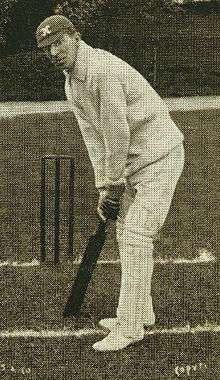George Gunn
 | ||||||||||||||||||||||||||||||||||||||||
| Cricket information | ||||||||||||||||||||||||||||||||||||||||
|---|---|---|---|---|---|---|---|---|---|---|---|---|---|---|---|---|---|---|---|---|---|---|---|---|---|---|---|---|---|---|---|---|---|---|---|---|---|---|---|---|
| Batting style | Right-hand bat | |||||||||||||||||||||||||||||||||||||||
| Bowling style | Right-arm bowler | |||||||||||||||||||||||||||||||||||||||
| International information | ||||||||||||||||||||||||||||||||||||||||
| National side | ||||||||||||||||||||||||||||||||||||||||
| Career statistics | ||||||||||||||||||||||||||||||||||||||||
| ||||||||||||||||||||||||||||||||||||||||
| Source: | ||||||||||||||||||||||||||||||||||||||||
George Gunn (13 June 1879 in Hucknall, Nottinghamshire – 29 June 1958 in Cuckfield, Sussex) was an English cricketer who played in 15 Tests from 1907 to 1930. Along with other notable batsmen such as Jack Hobbs, Frank Woolley and Phil Mead, he was one of a group who, beginning their first-class careers in the Edwardian Era, seemed to go on for ever. In Gunn's case, it was from 1902 to 1932, in the course of which he made more runs for Nottinghamshire than anyone else, before or since: 31,592 at 35.70.[1]Christopher Martin-Jenkins wrote of him: "A whimsical artist, George Gunn was capable of making runs against any attack, orthodox or unorthodox, as the mood took him. His record in a long career is outstanding, but all who saw him play regularly seem agreed that he should have scored even more runs than he did." [2]
His Test career was an unusual one, all but one of his 15 Tests being outside England. He was not selected for the 1907-8 tour of Australia, but visited the country anyway, for the good of his health. It was arranged that he could be called upon by England if necessary. In the event, it was necessary, and he appeared in the first Test at Sydney. Scores of 119, in his first innings in Test cricket, and 74 ensured that he would play in all five Tests. He made another century, 122, in the fifth Test, also at Sydney. He topped the averages, with 462 runs at 51.33. He was only chosen for one Test in England's home series against Australia in 1909, making 0 and 1 in the second Test at Lord's, but toured again in 1911-2. Though not quite as successful as four years earlier, he made 381 runs at 42.33. After World War I, he was out of favour, and his final four Tests did not come until 1929-30, on a tour to the West Indies when several veteran players (e.g. Rhodes and Sandham) seem to have been chosen as a reward for long service.
He was a member of a notable Nottinghamshire cricketing family, being a younger brother of John Gunn and a nephew of William Gunn, both of whom also played Test cricket, and the father of G. V. Gunn. He scored 164 not out on his fiftieth birthday, 13 June 1929, at Worcester. In 1931, at the age of 52 he scored 183 against Warwickshire, with his son scoring 100* in the same innings, a unique occurrence in first-class cricket.
He was a Wisden Cricketer of the Year in 1914.
Notes
- ↑ Christopher Martin-Jenkins, The Wisden Book of County Cricket, Queen Anne Press, 1981, ISBN 0-362-00545-1, p294.
- ↑ Martin-Jenkins, p33.